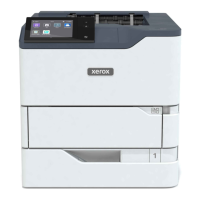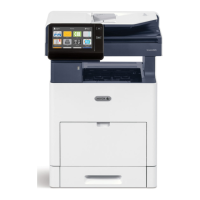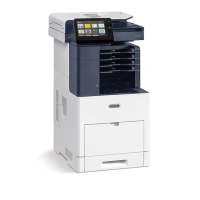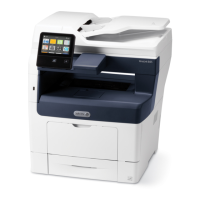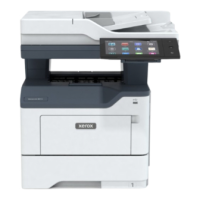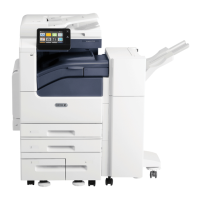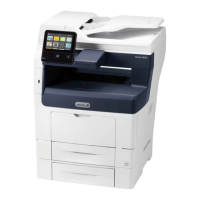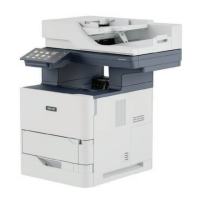
Do you have a question about the Xerox VersaLink B625 and is the answer not in the manual?
| N-up printing | 2, 4, 6, 8, 9, 16 |
|---|---|
| Duplex printing | Yes |
| Print technology | Laser |
| Maximum resolution | 1200 x 1200 DPI |
| Duplex printing mode | Auto |
| Warm-up time (from sleep mode) | 2.9 s |
| Time to first page (black, normal) | 4.1 s |
| Print speed (black, normal quality, A4/US Letter) | 65 ppm |
| Storage media | eMMC |
| Internal memory | 4096 MB |
| Processor cores | 4 |
| Internal storage capacity | 32 GB |
| Sound power level (standby) | 32 dB |
| Sound power level (printing) | 72 dB |
| Sound pressure level (standby) | 14 dB |
| Sound pressure level (printing) | 56 dB |
| Custom media width | 98.4 - 216 mm |
| Maximum print size | 216 x 356 mm |
| Custom media length | 191 - 356 mm |
| Paper tray media types | Bond paper, Card stock, Envelopes, Labels, Letterhead, Lightweight paper, Plain paper, Pre-Printed, Recycled paper |
| Paper tray media weight | 60 - 176 g/m² |
| ISO A-series sizes (A0...A9) | A4, A4+, A5 |
| Maximum ISO A-series paper size | A4 |
| Auto Document Feeder (ADF) media weight | 52 - 120 g/m² |
| Wi-Fi | No |
| Cabling technology | 10/100/1000Base-T(X) |
| Security algorithms | 256-bit AES, 802.1x RADIUS, FIPS 140-3, HTTPS, IPSec |
| Ethernet LAN data rates | 10, 100, 1000 Mbit/s |
| Mobile printing technologies | Apple AirPrint, Mopria Print Service, Xerox PrintBack |
| Supported network protocols (IPv4) | TCP/IP: HTTP/HTTPS, Internet Printing Protocol, LPR/LPD, Raw Socket Printing/Port 9100, IPv4/IPv6, WSD |
| Supported network protocols (IPv6) | IPv6 |
| Printing colors | Black |
| Duplex functions | Copy, Fax, Print, Scan |
| Maximum duty cycle | 300000 pages per month |
| Number of print cartridges | 1 |
| Page description languages | PCL 5c, PCL 6, PDF, PostScript 3 |
| Scan to | E-mail, E-mail Server, File, Network folder, OCR, PC, USB |
| Scan drivers | TWAIN, WIA |
| Scanner type | ADF scanner |
| Maximum scan area | 215.9 x 355.6 mm |
| Output color depth | 24 bit |
| Scan speed (black) | 75 ppm |
| Output grayscale depth | 8 bit |
| Image formats supported | JPEG, TIFF |
| Document formats supported | |
| Optical scanning resolution | 600 x 600 DPI |
| Total input capacity | 650 sheets |
| Total output capacity | 550 sheets |
| Maximum input capacity | 3850 sheets |
| Total number of input trays | 2 |
| Multi-Purpose tray input capacity | 100 sheets |
| Auto document feeder (ADF) input capacity | 200 sheets |
| Current rating | 5.3 A |
| Browser supported | Brave Browser, Chrome, Microsoft Edge, Mozilla Firefox, Opera, Safari |
| Maximum scan area (ADF) | 216 x 355 mm |
| Minimum scan area (ADF) | 76 x 127 mm |
| Copier resize | 25 - 400 % |
| Maximum number of copies | 9999 copies |
| Operating temperature (T-T) | 10 - 32 °C |
| Operating relative humidity (H-H) | 8 - 80 % |
| Package depth | 650 mm |
| Package width | 550 mm |
| Package height | 565 mm |
| Package weight | 28900 g |
| Control type | Touch |
| Product color | Black, Grey |
| Display diagonal | 7 \ |
| Market positioning | Business |
| USB connector | USB Type-A / USB Type-B |
| Optional connectivity | Bluetooth, Wireless LAN |
| USB 2.0 ports quantity | USB 2.0 ports have a data transmission speed of 480 Mbps, and are backwards compatible with USB 1.1 ports. You can connect all kinds of peripheral devices to them. |
| AC input voltage | 220 - 240 V |
| AC input frequency | 50/60 Hz |
| Power consumption (max) | 796 W |
| Power consumption (off) | 1.7 W |
| Power consumption (standby) | 31 W |
| Faxing | Color faxing |
| Fax resolution (color) | 400 x 400 DPI |
| Included cartridge capacity (black) | 10000 pages |
| Mac operating systems supported | Mac OS X 10.13 High Sierra, Mac OS X 10.14 Mojave, Mac OS X 10.15 Catalina, Mac OS X 10.15.3 Catalina, Mac OS X 11.0 Big Sur, Mac OS X 12.0 Monterey, Mac OS X 13.0 Ventura |
| Server operating systems supported | Windows Server 2008, Windows Server 2008 R2, Windows Server 2012 R2, Windows Server 2016, Windows Server 2019 |
| Windows operating systems supported | Windows 10, Windows 11, Windows 8, Windows 8.1 |
| Depth | 578.4 mm |
|---|---|
| Width | 558.8 mm |
| Height | 739.1 mm |
Key safety instructions and warnings for printer operation.
Explains symbols, warnings, and cautions used in the manual.
Guidelines for safe handling of electrical components and power connections.
Precautions for safe operation, including printer placement and handling.
Safety measures to follow during printer maintenance procedures.
Contact details for safety and environmental inquiries.
Definitions and meanings of all symbols used throughout the manual.
Identification and illustration of the printer's physical components.
Information on powering the printer on/off and managing power states.
Methods for user authentication and accessing printer features.
Overview of printer applications, features, and their capabilities.
Description of printable pages for printer configuration and status information.
Guide to accessing and configuring the printer via its web interface.
Step-by-step instructions for printer installation and initial setup.
Methods for connecting the printer via USB, Ethernet, or wireless networks.
Initial configuration steps for the printer via control panel or web interface.
Procedures for installing print drivers on various operating systems.
Resources for additional printer details, support, and documentation.
Introduction to personalizing the printer interface for user workflow efficiency.
Customizing the Home screen, apps, and default settings.
How the printer suggests workflow optimizations based on user activity.
Creating and managing custom apps for frequent or complex tasks.
Setting up automated workflows for scanning and copying tasks.
Steps to remove all user-specific personalization settings.
Browsing, downloading, and managing applications from the Xerox App Gallery.
Accessing and configuring device settings, status, and information pages.
Managing print jobs: viewing, pausing, deleting, and releasing jobs.
Instructions for making copies and customizing copy features.
Procedure for copying both sides of an ID card onto a single page.
Scanning documents and sending them as email attachments.
Scanning documents to various destinations using predefined workflows.
Scanning documents to destinations like email, USB, network, or remote locations.
Sending and receiving faxes using the printer's fax capabilities.
Sending faxes over a network via a fax server.
Printing files from USB drives, saved jobs, or mailboxes.
Printing documents sent via email to the printer.
Creating personalized content using templates for printing.
Ensuring correct setup and driver installation before initiating print jobs.
Configuring print settings via driver preferences for various print jobs.
Managing print jobs: viewing, pausing, deleting, and releasing jobs.
Options for paper selection, scaling, image control, and print quality.
Defining and saving custom paper sizes for printing requirements.
Printing files from USB drives, saved jobs, or mailboxes.
Description of printer paper trays and supported media types.
Guidelines for using various paper and media types for optimal print quality.
Setting paper tray configurations for adjustable or dedicated modes.
Instructions for loading paper into standard and high-capacity trays.
Guidelines and procedures for printing envelopes and labels.
Important safety warnings and precautions before performing printer maintenance.
Procedures for cleaning the printer exterior, scanner glass, and rollers.
Information on printer consumables and routine maintenance item replacements.
Viewing meter readings and printing billing summary reports.
Safe procedures for physically moving the printer.
Basic steps to locate and resolve common printer problems, including restarting.
Locating, minimizing, and clearing paper jams from various printer areas.
Identifying and resolving issues affecting print, copy, and scan quality.
Troubleshooting issues related to sending and receiving faxes.
Accessing error messages, history, and support logs for troubleshooting assistance.
Details on standard features, configurations, and available options for the printer.
Dimensions and weight of the printer in various configurations.
Required installation space and clearance around the printer.
Operating temperature, humidity, and elevation limits for optimal performance.
Power supply voltage, frequency, and current requirements.
Information on printing resolution and speed capabilities.
Contact details for environmental, health, and safety inquiries.
Compliance with electromagnetic emission and immunity standards (FCC, IC).
Legal restrictions on reproducing specific documents across different countries.
Requirements for fax transmission and telephone line connections (US, Canada, EU).
Compliance with international product safety standards (IEC, EN).
Information sources for material safety data regarding the printer.
General considerations for the disposal of Xerox products globally.
Xerox take-back and recycling programs in North America.
Disposal regulations for electrical equipment and batteries in the EU (WEEE Directive).
Guidance for product disposal in countries outside the European Union.
Details on features available for various printer applications like Copy, Email, Fax, Scan.
